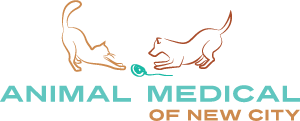Leptospirosis is a bacterial disease of dogs that can affect the blood, liver, or kidneys. It is caused by spiral shaped bacteria called leptospires and can affect humans as well as many domestic and wild animals.
How do dogs acquire the infection?
The bacteria are spread through the urine of infected animals which can get into water or soil. The bacteria can survive in the environment for weeks to months. Humans and animals can become infected through contact with contaminated urine, water or soil. The bacteria can enter the body through skin (either through broken skin or intact skin after long periods of immersion in water) or mucous membranes (eyes, nose or mouth). Infected animals can shed the bacteria into the environment for a few months up to several years. The incubation period (from infection to onset of clinical signs) is usually 5-14 days.
What are the signs of leptospirosis?
Many infections go undetected, but many other cases can be life-threatening. There are three main forms of the disease: hemorrhagic (bleeding), icteric (liver), and renal (kidney). In the hemorrhagic disease there is early high fever with lethargy and loss of appetite. Multiple small hemorrhages occur in the mouth and on the whites of the eyes. Bloody diarrhea and vomiting may occur. This form is often fatal. The icteric form begins much like the hemorrhagic form, and many of the signs are the same. It differs in the presence of a yellow color (jaundice or icterus) in the mouth and whites of the eyes. In severe cases in dogs with white hair, the skin will turn yellow. The renal form causes kidney failure. These dogs are very lethargic, anorectic, and experience vomiting. Their mouth may have a very offensive odor and ulcers often develop on the tongue. This form may be fatal, but recovered dogs often have chronic kidney disease.
How common is leptospirosis?
The prevalence of this disease varies from region to region and is correlated with rainfall and temperature. Leptospirosis outbreaks usually occur after hurricanes or periods of heavy rainfall. Dogs that spend a lot of time in the woods (hunting, hiking, camping, etc), in the water or other endemic areas (such as Long Island) are at increased risk for exposure. Humans that are at increased risk for infection are those that work with animals (such as veterinarians,
kennel assistants, farmers, etc), sewer workers, campers, swimmers and triathletes. Approximately 50% of human cases in the United States occur in Hawaii.
What is the treatment?
Antibiotics are reasonably effective if they are begun promptly. If an animal is treated early, it may recover more rapidly and with less severe permanent organ damage. However, many of these dogs are very ill and require hospitalization for intravenous fluid therapy and in some cases, dialysis.
How can leptospirosis be prevented?
There is an annual canine vaccine for leptospirosis. Initially, a dog or puppy will receive two vaccination boosters three weeks apart. After this initial booster series, the vaccine is then administered yearly. Because there are many strains of leptospires, this vaccine does not provide 100% protection against all of the known strains. However, this vaccination is recommended for all dogs that are considered to be high risk for exposure (as discussed above).
In addition, since rodents can carry and spread the bacteria, it is recommended that rodent problems are kept under control.
Can the vaccine cause reactions?
Soreness and swelling at the injection site, lethargy and loss of appetite are common reactions. However, these reactions generally only persist for 2-3 days. Once recovered, the vaccinated dog is protected against the disease.
How can people protect themselves if their dog has leptospirosis?
The primary mode of transmission of leptospirosis from pets to humans is through direct or indirect contact of contaminated animal tissues, blood or urine. Normal daily activities with pets typically do not put people at high risk for leptospirosis infection. However, assisting in the delivery of newborns from an infected animal is considered a high risk activity for transmission of leptospirosis. Contact your physician if any of the high risk contacts occur with your pet during the time of its infection.
How To Handle An Infectious Animal
The following outlines safety guidelines recommended when dealing with an infected animal:
- Do not handle or come in contact with urine, blood or tissues from your infected pet before it has received the appropriate treatment.
- If contact with animal tissues, blood or urine is necessary, wear protective clothing such as gloves and boots.
- As a general rule, always wash your hands after handling your pet or anything that might have your pet’s excrement on it.
- When cleaning contaminated surfaces, use an antibacterial cleaning solution of 1 part bleach to 10 parts water.
- Administer all of your pet’s medicine as prescribed and follow up with your veterinarian as recommended.

